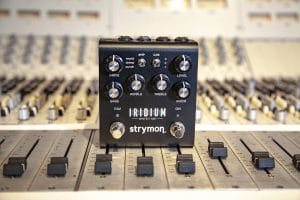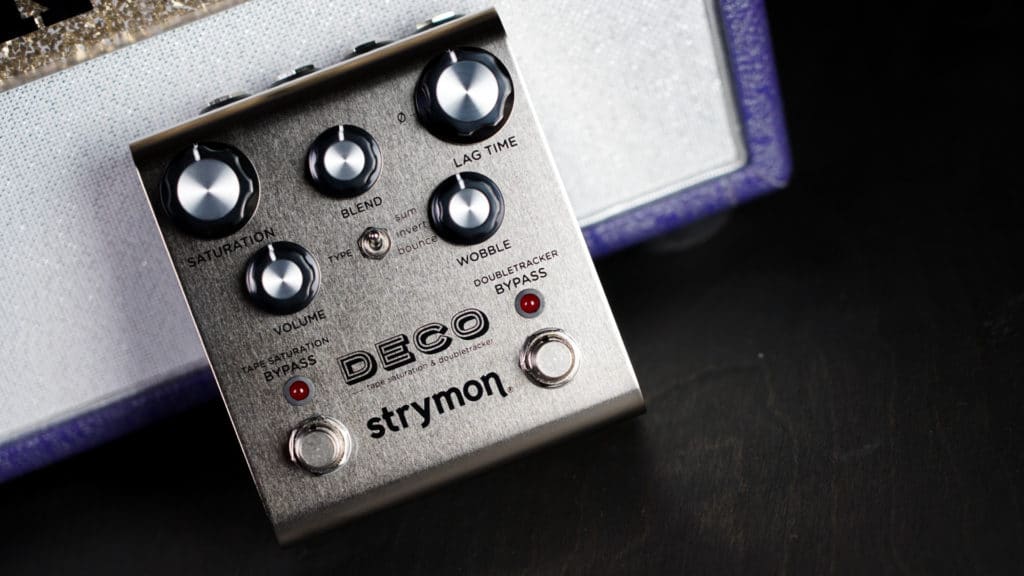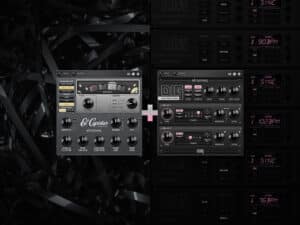
Iridium vs. Real Marshall (Andertons Music Co. Blindfold Challenge!)
Since Iridium was first launched back in 2019, there’s now more options than ever for musicians looking for tube amp tone and feel direct from
Free US Shipping On Orders Over $49
Easy 30-Day Returns
Financing Available Through ![]()

The most common question that customers ask us about Deco Tape Saturation and Doubletracker goes something like this: Where should I put Deco on my pedalboard? Do I put it with my drives? What about modulation? At the end of my signal path like you would a tape machine? The answer is pretty simple, and it comes down to how exactly you want to use Deco in the first place.
Are you looking to set it to Wide Stereo Mode for warbly back and forth stereo goodness? Are you hoping to use the Tape Saturation for a bit of warmth and gain before going into your amp or recording interface?
Then set it at the very end as the last pedal before your amps, monitors, interface, etc.
Are you using it as an all-in-one delay/modulation/drive Swiss-Army knife? Does it serve as your modulation and delay, as well as an overdrive or boost?
Then put it after your drive section but before your modulation and other time-based pedals.
These are just a few examples, but the exact sounds and functionality you want to get out of Deco will determine the best place to put it within your signal path.
We’ve seen that there are a few main placements for Deco that most people go with, and we’re happy to share these with you in case you’re in need of some inspiration as to how to get the most out of your Deco!

For some people, Deco serves as their desert island pedal — a jack of all trades that functions as a delay, flanger, and chorus on one side, and anything from a boost to full-on overdrive on the other.
If you’re using Deco in this configuration, Deco might best be suited to live after your overdrives, but before any time-based effects such as modulation, delay, or reverb.
This is handy if you like stack overdrives, and allows you to pair Deco’s Tape Saturation with any drive pedals you have placed before it, while also keeping your tone as clean as possible by having your drive placed before your modulation, delay, and reverb.

Another popular use for Deco is as a sort of end of the signal path treatment — the Tape Saturation side of Deco works nicely to add some natural tape warmth to any signal before going into a mixer or recording interface, the kind of subtle effect that’s not noticeable until it’s not there. This works great on vocals, drums, or bass.
You can also pair this with the Doubletracker: Set the BLEND time to maximum for no reference deck, LAG TIME to 9:00 or before, and WOBBLE to 3:00 or higher for a vibrato that wobbles at random intervals. This works great for adding a bit of warped vinyl-esque movement to any signal.
For this use case, Deco should be placed very last in the signal path, before you go out to your amp(s)/interface/mixer/etc.

When using stereo output on Deco, its Wide Stereo secondary function is a great tool for creating some unique effects. You can read more about how to dial up Wide Stereo Mode as well as what it does here.
Essentially, the Reference Deck of the Doubletracker is sent to the LEFT OUT, and the Lag Deck is sent to the Right Out. The BLEND knob then acts as a panning control to determine how much of each deck you hear in your monitoring device. You can then use the LAG TIME knob to determine how far behind the Lag Deck is relative to the Reference Deck, directly impacting the effect you will hear.
At shorter LAG TIME settings around 9:00 or so, the decks are very close together and with a bit of WOBBLE can create a nice lush flanger, while at the longest lag time you get a full 500mS delay, which can be used to create a noticeable echo between your left and right audio channels
When using Deco like this, you can place it at the very end of your signal path before going to your speakers if you would still like it to act as an end of the signal path treatment, but you can also get creative with it. Place Deco before a stereo delay to trigger said delay at different times, depending on what your LAG TIME is set to, or use Wide Stereo Mode as a wet/dry splitter where you can separately process the Lag Deck and Reference Deck.
As you can see, the possibilities are many with Deco, and we hope that these examples serve to give you some ideas as to where Deco might best live within your signal path.
If you have questions about these or any other Strymon products, don’t hesitate to reach out to us at [email protected].
Have an idea for a blog or a question about Strymon, our products, or effects in general? Comment below!
Subscribe to our newsletter to be the first to hear about new Strymon products, artist features, and behind the scenes content!

Since Iridium was first launched back in 2019, there’s now more options than ever for musicians looking for tube amp tone and feel direct from

From the moment we first started releasing guitar pedals, we were asked an inevitable question: “When is this being released as a plugin?” We’re happy

Happy New Year from all of us here at Strymon! We hope you’ve had a wonderful holiday season filled with friends, family, and music. We’re
13 Responses
Thank you so much for this! I still haven’t experimenting on my Deco for quite sometime due to the limitations I know of off it despite checking out the demos online. I would really like to tap its full potential!
Keep it up, Strymon!
P.S. How do I clean the outside chassis? It seems that if my hands are a bit moist, it tends to have a finger print/mark on it. And when I forgot to clean it before I put it inside the box, the finger print/mark will stick.
Glad you found this helpful!
We usually use a little bit of denatured alcohol on a cotton ball or microfiber towel to clean the chassis. Just be sure the pedal is powered off and completely dry before you power the pedal back up.
Hi Gohan! My first Strymon pedal was an OB1 and then a Flint. But since I bought an Iridium last year, my pedalboard has become an “all Strymon” board, with the exception of a Peterson Strobostomp tuner and a Digitech Drop. The Compadre and the Sunset had replaced other pedals and now, finally, a Deco is on its way. My days of playing live are long gone and now I mostly spend my days writing and recording. I’m planning on using the Deco last in the chain, so I’ve read your article with attention, but I have a doubt that I hope you may help me resolve.
My chain goes like this: Guitar (mono out to) Tuner (mono out to) Drop (mono out to) Compadre (mono out to) Sunset (mono out to) Iridium (stereo out to) Flint (stereo out to) Duet Apogee (stereo out to) Mac.
I’m planning on using the Deco in Wide Stereo Mode mainly to tighten up my rhythm guitar signal, giving it a warm tape feel and also to doubletrack it and, from time to time, just use a little bit of delay, chorus or flanger in some small guitar parts, background arrangements and other not so protagonist guitar licks.
As you may see, now I’m using the Iridium and Flint like they are my stereo amp so, finally, after this boring paragraphs that I’ve written, my doubt goes like this: Should I place the Deco after my Iridium+Flint “amp” or, before them and after the Sunset?
Thanks for reading all this and your answer!
Hello, and welcome to the Strymon family! I’d experiment with placing your Deco either completely last, or before your Iridium and Flint. Dead last will give you the most dramatic effect when in Wide Stereo Mode, especially when using reverb. If you want to use it a bit more conventionally, then place it before your Iridium + Flint.
Excellent, Gohan; thanks for your answer!!
Since I’m growing old way too fast, I’m turning more conventional each day, so I’ll start the experiment placing the Deco before the Iridium+Flint. But the little punkrock kid that is still alive inside of me can’t wait to place it dead last. “The most dramatic effect” was a selling point 🙂
Thanks again for your help!! I really enjoy reading the blog.
Always looking forward for new Strymon releases
Where do I place the chorus . Before or after the iridium ? Also the el capistan
If you’re using Deco for chorus, I’d place it after Iridium. I’d also place El Capistan after Iridium.
Hi,
I have the first version of the Deco, where the input mono/stereo function is selected internally using a jumper switch. So when stereo is enabled internally but the Deco input is connected to a mono pedal signal, how is that mono signal routed through the pedal? Does it pass through the Deco on just one of its internal channels or is the same mono signal placed on both internal stereo channels?
In other words, does the pedal process a mono signal identically, regardless of whether the input jumper switch is configured to mono or stereo?
Also, will your answer apply to every Strymon pedal that has this internal mono/stereo jumper switch?
Thanks!
Hey there Henry,
The stereo/mono jumper switch specifically determines input type. If you have it set for TRS input but are giving it a TS input, you will only hear half of the signal if using both outputs. This is the same for all TRS input Strymon pedals. Please contact [email protected] if you have any more questions!
What about the send and return on an amp?
Can I use the Deco in this loop?
Yes, absolutely!
But what is the result if I place the Deco in the send/return loop with the saturation/overdrive activated? I don’t see any problem for the doubletracker channel. That is the correct position for modulation effects but not for saturation, or am I seeing it wrong?
The result is you’d get Deco’s saturation after your amp’s preamp. Not necessarily right or wrong, just a different sound. Same way that having Deco outside of the FX loop going into your preamp first will yield a different tone. There’s not really a way to get just the Doubletracker in the loop and the Saturation before the loop, so you’ll need to try both out and see which sounds better to you.